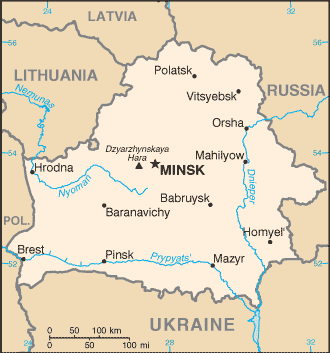Belarus is located east of Poland and has a total area of 207,600 km2. The population of this nation as of July 2012 is 9,643,566. The country’s climate varies between continental and maritime.
 |
The national flag of Belarus.
Image Credit: CIA Factbook. |
Belarus was a part of the former Soviet Union and attained its independence in 1991. It continues to have a good relationship with Russia compared to the other Soviet republics. The current government imposes restrictions on freedom of speech, the press, peaceful assembling, and religion. The government owns about 80% of all industries. The hostile stance of the government has prevented foreign investment. The GDP of the country was $143.6 billion in 2011.
The economy of Belarus is currently dependent on the $3 billion loan from the Eurasian Economic Community Bail-out Fund, a $1 billion loan from the Russian bank Sberbank, and the $2.5 billion sale of Beltranzgas to Russia’s state-owned Gazprom.
The natural resources of Belarus are limited and include peat deposits, and small quantities of oil and natural gas, granite, gravel, limestone, marlstone, chalk, sand, and clay. Belarus imports most of its crude oil and natural gas from Russia at low prices.
Overview of Resources
The chief mineral production companies in Belarus are as follows:
- Two metal works plants
- Two crude oil refineries
- Nitrogen production enterprise
- Potash mining company.
OAO Belaruskali is one of the leading potash producers in the world .
There are small deposits of iron ore, nonferrous metal ores, dolomite, potash, rock salt, phosphorites, refractory clay, sand for glass production, and many building materials. The country also has deposits of industrial diamonds, titanium, lead, mercury, bauxite, nickel, vanadium, copper ore, and amber. However, the mining sector is small scale and progresses at a slow pace.

The map of Belarus. Image Credit: CIA Factbook
Metals
In 2010, the Byelorussian Steel Works (BMZ) was the top producer of iron and steel in Belarus. Its main plant at Zhlobin produced about 90% of total national steel production.
The production statistics of the plant is as follows:
- 2,530,949 t of raw steel
- 2,098,711 t of rolled steel
- 97,027 t of steel pipes
- 92,883 t of steel cord
- 37,177 t of hose wire
- 29,937 t of bronze-plated bead wire
- 193,868 t of other steel wire.
BMZ also owned the Gomel Casting Plant OAO Mogilev Metallurgical Works (MMZ), and the Rechitsa Metizny Plant (RMZ).
Industrial Minerals
The three main companies involved in cement production in Belarus are listed below:
- PRUP Krichevzementnoshifer (Mogilev region) - 1.8 million Mt/yr production capacity
- Cement Plant (BCZ) or Kostyukovichi Cement Plant (Mogilev region) - produces cement, chalk, and lime. About 1.1 Mt/yr cement production capacity
- OAO Krasnoselskstroymaterialy or Volkowysk Cement Plant (Grodno region) – produces cement, chalk, concrete blocks, dry builders mixes, asbestos boards, and lime. Nearly 900,000 t cement production capacity.
However, in 2010 these companies could not meet the domestic cement demand which was about 4.5 Mt/yr.
In 2010, Iran’s Azarab Industries began constructing a new cement plant in the Gomel region.
The main producer of nitrogen-based fertilizers and liquid ammonia in Belarus is Grodno Azot. The company produced the following commodities:
- Ammonium sulfate
- Biodiesel fuel
- Caprolactam
- Carbamide
- Carbamide-ammonium nitrate mixture (CAN)
- Liquid ammonia
- Liquid carbon dioxide
- Methanol.
Potash is the leading export product for Belarus. In 2010, potash exports were valued at more than $2.2 billion. The production of potash increased to 5.2 Mt from 2.5 Mt in 2009.
Fossil Fuels
Peat is produced in Belarus by a number of small plants located all over the country. In order to increase production of peat, a new government program for the period of 2008 through 2020 was initiated. Its aim was to increase peat production from 2.4 Mt in 2010 to 4.4 Mt/yr by 2020.
The petroleum reserves of Belarus are limited. The government also sets limitations regarding the annual extraction of mineral resources such as petroleum, salt, and sand. Based on the limitations the annual petroleum extraction in 2010 was 1.70 Mt compared to 1.72 Mt in 2009. The limitation was set at 1.68 Mt in 2011.
Investment
Mining experts believe that Belarus will play a significant role as a major provider of potash in the coming years. The country will develop the Starobin deposit to increase production.
Regarding its fuel requirements, the government is involved in price negotiations with Russia and also has made oil supply deals with Azerbaijan, Kazakhstan, and Venezuela.
In recent news, Russia’s Urakali and Belaruskali of Belarus have informed potash importers of India to begin negotiating price with them and assured the importers that discounts will be given on their export offer price. India has been granted this favor as it is one of the largest importers of potash.
Belarus is constructing the Garlyk mining and processing complex in Turkmenistan. On completion, this complex will be under permanent control of the Belarusian government. Though there have been delays, all underground and surface works is expected to be completed by April 2013.
The need for financial resources might cause the government to start privatization and even sell some of its companies in the near future. Belarus will need to focus on building business networks with many more countries so as to develop its mining sector and financially gain from it.
Disclaimer: The Author of this article does not imply any investment recommendation and some content is speculative in nature. The Author is not affiliated in any way with any companies mentioned and all statistical information is publically available.
Sources
Disclaimer: The views expressed here are those of the author expressed in their private capacity and do not necessarily represent the views of AZoM.com Limited T/A AZoNetwork the owner and operator of this website. This disclaimer forms part of the Terms and conditions of use of this website.